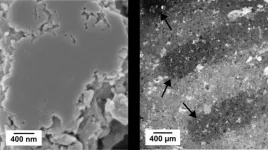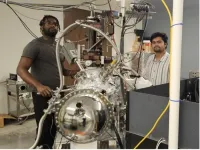(Press-News.org) A new paper published today in Molecular Biology and Evolution reveals that it's not as straightforward as it might seem. Despite decades of data collection by the United Nations Office on Drugs and Crime (UNODC), which has been valuable to monitor changes in areas occupied by illegal coca plantations in South America, there is no reliable scientific method to distinguish between different types of coca plants.
South American coca plants have been essential to Andean and Amazonian communities for at least 8,000 years. It is within these communities that they are thought to have evolved from wild to domesticated coca plants. Their leaves, packed with many active compounds, just one of these being cocaine, play a central role in social organisation and cultural identity of many communities, as well as being used for medicinal treatments, as nutritional supplements, and everyday stimulants. However, the global demand for cocaine as a recreational and criminalised drug has driven intensive cultivation of coca and contributed to deforestation and conflict in the region.
Coca plants belong to the Erythroxylum genus, which includes over 270 species, mostly native to the American tropics. Two primary species of cultivated coca are Erythroxylum coca and Erythroxylum novogranatense, grown mostly in different regions of northwestern South America, but with some geographical overlap. Because of domestication, these plants were thought to have distinctive leaf shapes—smaller, rounder, and softer compared to wild species. Furthermore, the simple difference of rounder size in E. coca compared to E novogranatense has been used in attempts to identify species growing in plantations.
However, the study by researchers from the University of Portsmouth and Royal Botanic Gardens, Kew, with international partners including Universidad Distrital, Bogotá, Colombia reveals that leaf size and shape are not reliable identifiers. Researchers examined 1,163 leaf outlines from 342 digital herbarium specimens of wild and cultivated coca. The statistical analysis showed a significant overlap between the species and varieties, making it difficult to distinguish between them.
Dr Natalia A. S. Przelomska, Lecturer in Bioinformatics at the University of Portsmouth said: "Existing methods for botanical species identification, as I was fortunate to learn first-hand from Colombian botanist Prof. Rocío Cortés-B., can be very effective in their simplicity. However, they become increasingly unreliable once one is looking at the level of varieties. This is a problem because there is a need to distinguish varieties grown exclusively for the illegal cocaine market from those that have enduring cultural significance, a whole host of traditional uses and quite likely also untapped medicinal potential. These varieties have been under Indigenous stewardship for millennia, yet we now have evidence that plantations for cocaine production are encroaching on Indigenous territories.”
The researchers also showed there are distinctive traits of cultivated coca leaves: being rounder overall and narrower at the base. Although unreliable for identification, these are valuable clues regarding how these plants might have evolved in human cultivation.
The team also explored genetic relationships between coca plants, comparing their findings with existing classifications. They discovered that distinct coca varieties began evolving long before humans arrived in South America approximately 15,000 years ago.
Dr Przelomska highlights the importance of genetic techniques as a more accurate method for identifying and monitoring coca plants. "Genetic data offer a clearer picture, when complemented with looking at leaves and other plant organs that can be useful for recognising species, like parts of flowers. Importantly, our genetic work reveals a complex history of evolution of the coca plant, which explains why there are uncertainties in its classification system. Once these are clarified, it will be more feasible to develop cost-effective genetic methods for identification.”
Dr Oscar Alejandro Pérez-Escobar from Royal Botanic Gardens, Kew, a senior author who, along with Director of Science Alexandre Antonelli played a role in conceptualising this project says: “One of the primary objectives of our research is to propose a stable classification system and a comprehensive genetic database. This will enable us to confidently identify the different populations, varieties and species of cultivated coca and their wild relatives. Such a system is crucial for developing sustainable bioprospecting programs and the coca tree holds immense potential in this regard. But first, it is essential to separate the plant’s valuable attributes from its association with the recreational drug, reshaping its perception and highlighting its positive uses.”
The paper, "Morphometrics and phylogenomics of coca (Erythroxylum spp.) illuminate its reticulate evolution, with implications for taxonomy," will be available on July 10th at https://academic.oup.com/mbe/article-lookup/doi/10.1093/molbev/msae114.
END
Tackling the challenge of coca plant ID: wild vs cultivated for cocaine
Ever wondered how scientists tell apart coca plants grown for different human uses (sometimes illegal) from those that grow wild?
2024-07-10
ELSE PRESS RELEASES FROM THIS DATE:
BESSY II shows how solid-state batteries degrade
2024-07-10
Solid-state batteries have several advantages: they can store more energy and are safer than batteries with liquid electrolytes. However, they do not last as long and their capacity decreases with each charge cycle. But it doesn't have to stay that way: Researchers are already on the trail of the causes. In the journal ACS Energy Letters, a team from HZB and Justus-Liebig-Universität, Giessen, presents a new method for precisely monitoring electrochemical reactions during the operation of a solid-state battery using photoelectron spectroscopy at BESSY II. The results ...
Researchers show promising material for solar energy gets its curious boost from entropy
2024-07-10
Solar energy is critical for a clean-energy future. Traditionally, solar energy is harvested using silicon – the same semiconductor material used in everyday electronic devices. But silicon solar panels have drawbacks: for instance, they’re expensive and hard to mount on curved surfaces.
Researchers have developed alternative materials for solar-energy harvesting to solve such shortcomings. Among the most promising of these are called “organic” semiconductors, carbon-based semiconductors that are Earth-abundant, cheaper and environmentally friendly.
“They can potentially lower the production cost for solar panels because these ...
Faculty physicians to establish new community "health village" at Mondawmin Mall
2024-07-10
University of Maryland Faculty Physicians has entered into an agreement to lease 17,000 square feet of space at The Village at Mondawmin, which would establish a new community "health village," University of Maryland School of Medicine (UMSOM) Dean Mark T. Gladwin, MD, and Faculty Practice President William F. Regine, MD, announced today. It is part of a larger effort to work in partnership with the West Baltimore community to develop and implement health care delivery based on neighborhood needs and to improve patient access to healthcare.
The Faculty Practice group of ...
Pitch perfect: match the message to the idea's newness, study finds
2024-07-10
In a study examining styles of pitching ideas to audiences, researchers found that pitches promoting radical ideas are better received when framed in concrete and explanatory ‘how’ terms, while progressive ideas do better with abstract ‘why’ style of pitches.
Previous research found that professional audiences, like investors, prefer concrete pitches with how-style explanations, while lay audiences such as students and crowdfunders respond better to ‘why’ style pitches for abstract ideas.
Professor Simone Ferriani, Professor of Entrepreneurship at Bayes Business School (formerly ...
MSU study reveals rapid growth, persistent challenges in telemedicine adoption among US hospitals
2024-07-10
EAST LANSING, Mich. – A new study led by Michigan State University researchers shows a significant increase in telemedicine services offered by U.S. hospitals from 2017 to 2022, while also highlighting persistent barriers to its full implementation.
The comprehensive analysis of telemedicine adoption in U.S. hospitals during these years reveals both significant progress and ongoing challenges in the health care sector’s digital transformation. The study, published in the Journal of General Internal Medicine, found that the percentage of hospitals offering at least one form of telemedicine ...
Cirrhosis affects twice as many transgender adults as cisgender adults
2024-07-10
LOS ANGELES — Cirrhosis is chronic, progressive end-stage liver disease that occurs when scar tissue prevents the liver from functioning normally. Studies have shown that two of the leading causes of cirrhosis — alcohol use disorder and viral hepatitis — occur more frequently in transgender individuals, but there has been little research examining if these risk factors translate into greater incidences of cirrhosis among transgender patients.
A new study from Keck Medicine ...
Astronomers find the nearest massive black hole, a missing link in massive black hole formation
2024-07-10
Omega Centauri is a spectacular collection of about ten million stars, visible as a smudge in the night sky from Southern latitudes. Through a small telescope, it looks no different from other so-called globular clusters: a spherical collection of stars, so dense towards the centre that it becomes impossible to distinguish individual stars. But now a new study, led by Maximilian Häberle (Max Planck Institute for Astronomy), confirms what astronomers had been suspecting for some time: Omega Centauri contains a central black hole. The black hole appears to be the “missing link” between its stellar and ...
Telehealth availability for mental health care during and after the COVID-19 public health emergency
2024-07-10
About The Study: Based on this longitudinal cohort study of 1,001 mental health treatment facilities, telehealth availability has declined since the public health emergency end with respect to scope and modality of services, suggesting targeted policies may be necessary to sustain telehealth access.
Corresponding Author: To contact the corresponding author, Ryan K. McBain, Ph.D., M.P.H., email rmcbain@mail.harvard.edu.
To access the embargoed study: Visit our For The Media website at this link https://media.jamanetwork.com/
(doi:10.1001/jamanetworkopen.2024.20853)
Editor’s Note: Please see the article for additional information, ...
Mobile media content exposure and toddlers’ responses to attention prompts and behavioral requests
2024-07-10
About The Study: The findings of this study suggest that use of touch-screen, engaging, tablet games by toddlers may inhibit early social-communicative interactions.
Corresponding Author: To contact the corresponding author, Dimitri A. Christakis, M.D., M.P.H., email dimitri.christakis@seattlechildrens.org.
To access the embargoed study: Visit our For The Media website at this link https://media.jamanetwork.com/
(doi:10.1001/jamanetworkopen.2024.18492)
Editor’s Note: Please see the article for additional information, including other authors, author contributions and affiliations, conflict of interest and financial disclosures, and funding and support.
# ...
The molecule that could alleviate stroke-related brain injury
2024-07-10
A newly developed molecule, LK-2, could inform new therapies for stroke-related brain injury, finds scientists at The Hospital for Sick Children (SickKids).
An ischemic stroke occurs when blood flow to a part of the brain is interrupted, depriving the brain cells of oxygen and nutrients. Without timely treatment, brain cells can die, resulting in permanent damage to the brain and its functions. Stroke is one of the leading causes of death and disability worldwide, affecting millions every year.
An international study published in Nature co-led by Dr. Lu-Yang Wang, a Senior Scientist in the ...
LAST 30 PRESS RELEASES:
Norbert Holtkamp appointed director of Fermi National Accelerator Laboratory
New agentic AI platform accelerates advanced optics design
Biologists discover neurons use physical signals — not electricity — to stabilize communication
Researchers discover that a hormone can access the brain by hitchhiking
University of Oklahoma researcher awarded funding to pursue AI-powered material design
Exploring how the visual system recovers following injury
Support for parents with infants at pediatric check-ups leads to better reading and math skills in elementary school
Kids’ behavioral health is a growing share of family health costs
Day & night: Cancer disrupts the brain’s natural rhythm
COVID-19 vaccination significantly reduces risk to pregnant women and baby
The role of vaccination in maternal and perinatal outcomes associated with COVID-19 in pregnancy
Mayo Clinic smartwatch system helps parents shorten and defuse children's severe tantrums early
Behavioral health spending spikes to 40% of all children’s health expenditures, nearly doubling in a decade
Digital cognitive behavioral treatment for generalized anxiety disorder
Expenditures for pediatric behavioral health care over time and estimated family financial burden
Air conditioning in nursing homes and mortality during extreme heat
The Alps to lose a record number of glaciers in the next decade
What makes a good proton conductor?
New science reporting guide published for journalists in Bulgaria
New international study reveals major survival gaps among children with cancer
New science reporting guide published for journalists in Turkey
Scientists develop a smarter mRNA therapy that knows which cells to target
Neuroanatomy-informed brain–machine hybrid intelligence for robust acoustic target detection
Eight SwRI hydrogen projects funded by ENERGYWERX
The Lundquist Institute and its start-up company Vitalex Biosciences Announces Strategic Advancement of Second-Generation fungal Vaccine VXV-01 through Phase 1 Trials under $40 Million Competitive Con
Fine particles in pollution are associated with early signs of autoimmune disease
Review article | Towards a Global Ground-Based Earth Observatory (GGBEO): Leveraging existing systems and networks
Penn and UMich create world’s smallest programmable, autonomous robots
Cleveland researchers launch first major study to address ‘hidden performance killer’ in athletes
To connect across politics, try saying what you oppose
[Press-News.org] Tackling the challenge of coca plant ID: wild vs cultivated for cocaineEver wondered how scientists tell apart coca plants grown for different human uses (sometimes illegal) from those that grow wild?




